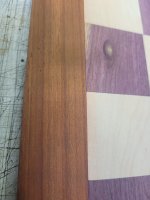Mike
Member
My #1 grandson and I are building him a chessboard. It is about 19" X 19" and has maple and purple heart squares with a frame of what I believe is some kind of rosewood. All but the purple heart were left from other projects in my shop. It is turning out nice so far.
The rosewood (if that's what it is) has a porous surface and we (grandson) want a glass finish.
I have been reading here and other places on the web about GluBoost fill and finish and have been thinking about trying it on pens, so I ordered the Fill n' Finish thin and non blush accelerator from EB. Thanks for the Peanut M&Ms Ed!! (it's hot here, had to put them in the fridge for a while before I could enjoy them)
Shop was about 85°F and 35% humidity. I wore nitrile gloves so I didn't glue myself to the work, a clean piece of old t-shirt for an applicator. The t-shirt material got a little hot and smoked, but not excessively. Maybe blue shop towels, per John U video?
I tried it on a scrap piece of the rosewood sanded to 400 grit and after 3 coats it filled most of the voids. I then used MinWax glossy WOP and it looks really good for a trial finish. Grandson is in Panama on a church mission this past week to supply indigenous people with eye glasses or he would be helping. He will be doing the finishing.
I believe with the right combo of GluBoost products, this finish is going to be great.
My question/issue is this: How much GluBoost will it take to fill and finish both sides of the board, and which product or combination of products should I use. It will take more coats to fill the rosewood than the maple and purple heart.
I have watched some of the GluBoost finishing videos and none I saw were finishing a surface this size. I have attached pics of the board sanded to 400 grit, no fill, etc.
Mike


The rosewood (if that's what it is) has a porous surface and we (grandson) want a glass finish.
I have been reading here and other places on the web about GluBoost fill and finish and have been thinking about trying it on pens, so I ordered the Fill n' Finish thin and non blush accelerator from EB. Thanks for the Peanut M&Ms Ed!! (it's hot here, had to put them in the fridge for a while before I could enjoy them)
Shop was about 85°F and 35% humidity. I wore nitrile gloves so I didn't glue myself to the work, a clean piece of old t-shirt for an applicator. The t-shirt material got a little hot and smoked, but not excessively. Maybe blue shop towels, per John U video?
I tried it on a scrap piece of the rosewood sanded to 400 grit and after 3 coats it filled most of the voids. I then used MinWax glossy WOP and it looks really good for a trial finish. Grandson is in Panama on a church mission this past week to supply indigenous people with eye glasses or he would be helping. He will be doing the finishing.
I believe with the right combo of GluBoost products, this finish is going to be great.
My question/issue is this: How much GluBoost will it take to fill and finish both sides of the board, and which product or combination of products should I use. It will take more coats to fill the rosewood than the maple and purple heart.
I have watched some of the GluBoost finishing videos and none I saw were finishing a surface this size. I have attached pics of the board sanded to 400 grit, no fill, etc.
Mike


